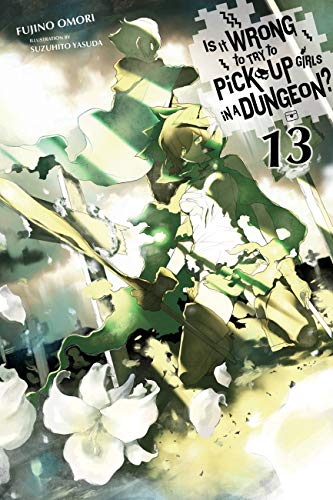By Fujino Omori and Kiyotaka Haimura. Released in Japan as “Dungeon ni Deai o Motomeru no wa Machigatte Iru Darou ka? Gaiden – Sword Oratoria” by Softbank Creative. Released in North America by Yen On. Translated by Dale DeLucia.
The long delay in the 14th book in the main series reaching North America has meant that the side series has been able to catch up quite a bit, and this book benefits from covering two books in the main series, the 10th and 11th, from the perspective of Loki Familia. Last time was very Aiz-heavy, and so she ends up not quite as featured in this book, though that does not mean that she’s not completely devastated by the end of it. And no, that doesn’t mean it’s Lefiya-heavy either, though she does get to barrel through the entire book fueled on pure rage at Bell, and also gets some of the more badass fight scenes. No, it’s Finn who’s the biggest protagonist in this book, as you might guess from the cover, which shows him, Aiz and Bell in a three-way standoff sort of situation. Bell inspires Aiz, much as he is unaware of this… and also, by the end of this book, Finn.
The majority of this book revolves around the Xenos getting out of Daedalus Street and back to the dungeon, only from the perspective of Loki Familia, who are here to kill them… well, that’s a secondary goal, but the primary goal is to use them to draw out the Evils and get another key (or two… or three…) to Knossos. Things are not helped by Hestia Familia, who are driving Finn and company to distraction (we see Lilly’s deception in this book from the Loki Familia side, where it just looks like picking on Raul, and it’s a lot less triumphant). Oh yes, and Hermes family is in there as well. And then there are the random adventurers who are simply really pissed at Bell, and the poor and orphaned who live here, who are also a little pissed at Bell, though they’re less certain about that.
Finn has no doubt that Bell is NOT being a selfish adventurer, but when he figures out his actual motive it’s tremendously difficult to accept. The story of Loki Familia has featured, time and again, folks who lost their families and loved ones to monsters. Aiz, Finn, Bete…it’s no wonder that Finn’s response, on hearing that these are intelligent monsters with emotions and morals of their own, is “I don’t care”. But seeing him gradually piece together what’s been happening, and fighting against his own instincts (which tell him not to kill these particular monsters), along with one of Riveria’s elves being saved by a Xenos taking the bullet, essentially, shows that he can’t simply stick by his rock-solid principles. He has to move forward just as fast, if not faster than Bell Cranel, and if that means changing how he thinks about monsters, then he will.
Of course, that doesn’t mean he’s not above using them, and he now has another group that can help them take on Knossos. The next two books seem to be tied together, and may be more Lefiya-centric. Which, given that Aiz ends this volume somewhat shattered, is probably a good thing. If you haven’t been reading this as it’s a spinoff, or because you hated the anime, please change your mind and get it immediately.




